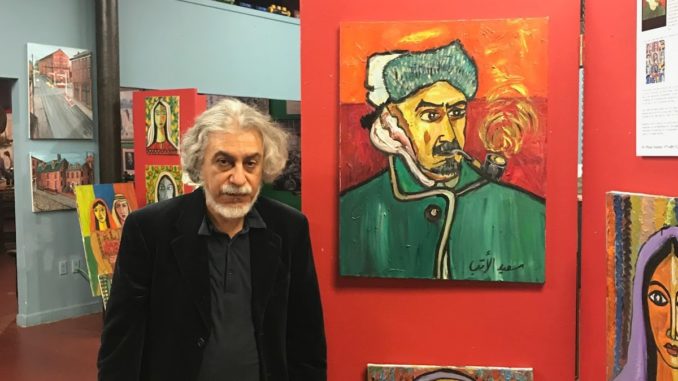
The entire months of September and October, the Paterson museum hosted the exhibit of local artist, Said Elateb. As we enter the museum, we see the entire length of the area is marked with Elateb’s colorful paintings. Many of them depict the faces of Arab women, and others depict the landscape of Palestine.
Looking at Elateb’s paintings, one might assume that he was Palestinian due to the prominence of Palestinian figures and culture within his artwork. Elateb explains why very quickly, “I am Lebanese but I lived in a refugee camp for Palestinians. I lived with Palestinians more than I lived with Lebanese people, and when I moved to America I lived with Palestinians again.”
Elateb explains that his father lived in Acca, Palestine, where he would paint ceilings. Through his business, his father was able to create a modest living for himself and his family. This all changed in 1948, “He used to live comfortably and happy as a painter, but then the Jews came, they kicked out all the refugees, he came back to Lebanon, with all the Palestinians. That’s how we came back to Sabra and Shatila. He carried that tragedy to us, he used to tell us how beautiful Palestine was.”
Sabra and Shatila are two refugee camps set up by the International Committee in 1949 to accommodate the influx of Palestinians fleeing to Lebanon after the Nakba in 1948. Elateb tells us that life in the refugee camp was difficult, and he often turned to art to express the misery of living in such conditions.
Elateb said, “I painted all throughout my life. When I went to this school, my teacher used to be the wife of Ismail Shammout, Tamam al Akhal.” Ismail Shammout and Tamam al Akhal are both well renowned and recognized Palestinian painters.
The theme of tragedy underlying Elateb’s life only continued. In 1982, the Lebanese Civil War broke out, and with it came the Sabra and Shatila Massacre, where a strategic attack from lebanese militant groups and the Israeli military left an upwards of 3,000 Palestinian refugees dead.
Elateb lost many friends and family members when the war broke out. At the time, he was eighteen years old, and he believed that the violence and destruction he witnessed needed to be captured. Therefore, he took up photography and became a war photographer, witnessing and capturing tragedies in Lebanon, Afghanistan, and Palestine.
In 1990, Elateb traveled to Palestine to photograph the Intifada. Elateb emphasized how he made sure to take pictures of normal life as well, such as pictures of people working and cooking.
Of his experience, he said, “I get surprised how Palestinians live there. It is real apartheid. And I always admire the Palestinian people how they can adjust to live there. If you see it’s like Nablus is in a jail, Gaza is a jail, Ramallah is a jail. And when you go inside you see people dancing doing Dabka having a wedding. You see kids fighting with the Israelis and the next block we see a wedding.”
Nowadays, Elateb is focusing on his art and paintings. “When I paint,” he says, “it gives me peace of mind, it gives me happiness. The brush controls you, you think you control the painting, but the painting controls itself.”A common theme he depicts in his art is the pain of women.
“The Arabic woman is a miserable women,” Elateb says. “She has someone over her head all the time, from the time she is a baby, to when she drops dead. She is stopped by her family, by her husband, or her sons. It’s a never ending cycle and they never appreciate her. That’s why they are all sad, I never see Arab women happy. They are sad and depressed, they have issues in their life. The Arab woman sacrifices for her family, but in the end she is not appreciated.”
When asked if he knew these women, Elatab replies, “Yes, I know all of them.”
Elateb’s greatest artistic inspiration is Vincent Van Gogh, he tells us as he shows us a painting of Jerusalem which he modeled in the style of Van Gogh’s “Starry Night.” He uses muted colors to depict a sense of melancholy. Elateb says he wants to show a sense of sadness because Jerusalem is not free, showing but the beauty and tragedy of the city on the canvas.
Elateb’s parallels with Van Gogh go deeper than art styles, however. Elateb says, “I have been inspired by Van Gogh, I like to relate to him because he was the greatest artist but was a complete failure for most of his life. He was never appreciated, and his brother used to help him with money, he was broke and depressed and nobody understood him. But when he died, he changed art completely.” Trailing off, he mutters, “No one ever appreciated him when he was alive, but when he died. Now everybody appreciates Van Gogh.”
Elateb closes the interview with a final message for the Arab American community.
“All I want from the community is to understand art and to help artists. We need the help of the community to respect art, for their benefit and for our own.”
